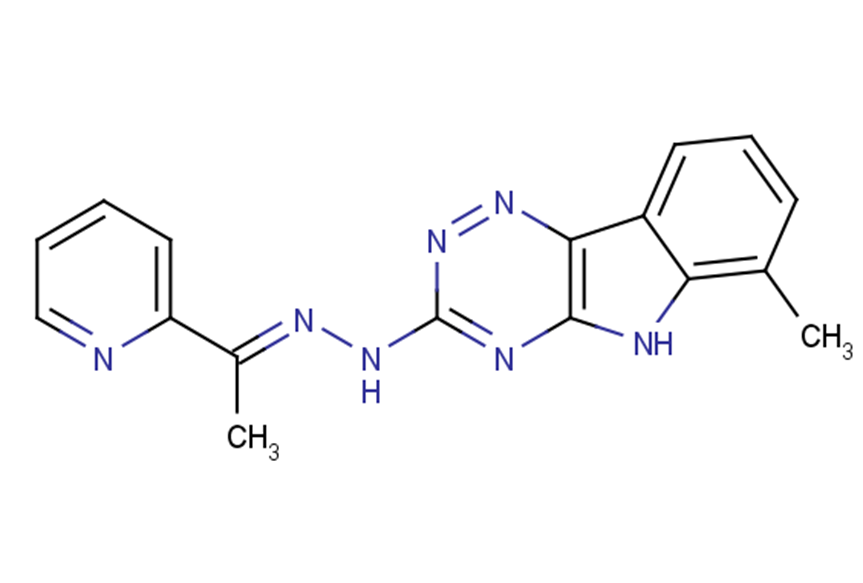
VLX600
CAS No. 327031-55-0
VLX600( —— )
Catalog No. M21963 CAS No. 327031-55-0
VLX600 is an iron-chelating oxidative phosphorylation (OXPHOS) inhibitor, is a cell-permeable anticancer agent.
Purity : >98% (HPLC)
 COA
COA
 Datasheet
Datasheet
 HNMR
HNMR
 HPLC
HPLC
 MSDS
MSDS
 Handing Instructions
Handing Instructions
| Size | Price / USD | Stock | Quantity |
| 5MG | 43 | Get Quote |


|
| 10MG | 69 | Get Quote |


|
| 25MG | 142 | Get Quote |


|
| 50MG | 237 | Get Quote |


|
| 100MG | 405 | Get Quote |


|
| 200MG | Get Quote | Get Quote |


|
| 500MG | Get Quote | Get Quote |


|
| 1G | Get Quote | Get Quote |


|
Biological Information
-
Product NameVLX600
-
NoteResearch use only, not for human use.
-
Brief DescriptionVLX600 is an iron-chelating oxidative phosphorylation (OXPHOS) inhibitor, is a cell-permeable anticancer agent.
-
DescriptionVLX600 is an iron-chelating oxidative phosphorylation (OXPHOS) inhibitor, is a cell-permeable anticancer agent. It acts by reducing mitochondrial oxidative phosphorylation in tumor cells.VLX600 as a drug that is preferentially active against quiescent cells in colon cancer 3-D microtissues. The anticancer activity is associated with reduced mitochondrial respiration, leading to bioenergetic catastrophe and tumour cell death. VLX600 shows enhanced cytotoxic activity under conditions of nutrient starvation. Importantly, VLX600 displays tumour growth inhibition in vivo. (In Vivo):VLX600 (16 mg/kg; i.v.; every third day for 16 days) shows anti-tumor activity in human tumor xenografts.
-
In VitroVLX600 (6?μM; 72 hours) induces an autophagic response.VLX600 is cytotoxic to HCT116 spheroids. VLX600 induces a HIF-1α-dependent glycolytic response. VLX600 inhibits oxygen consumption in HCT116 cells. VLX600 inhibits phosphorylation of the mTOR downstream effectors 4EBP1 and p70-S6K by an HIF-1α-independent mechanism. VLX600 preferentially leads to decreased ATP levels in cancer but not normal cells.Cell Proliferation Assay Cell Line:HCT116, HT29, SW620, HT8, DLD and RKO cells Concentration:0.1, 1, 10, 100μM Incubation Time:72 hours Result:Inhibited the proliferation of these cells.Western Blot Analysis Cell Line:HCT116 cells Concentration:6?μM Incubation Time:72?hoursResult:LC3-II was induced.
-
In VivoVLX600 (16?mg/kg; i.v.; every third day for 16 days) shows anti-tumor activity in human tumor xenografts. Animal Model:NMRI nu/nu mice (HCT116 and HT29 colon cancer xenografts)Dosage:16?mg/kg Administration:Intravenously; every third day for 16 days Result:Anti-tumor activity was observed in both HCT116 and HT29 colon cancer xenografts.
-
Synonyms——
-
PathwayOthers
-
TargetOther Targets
-
Recptoroxidative phosphorylation (OXPHOS)
-
Research Area——
-
Indication——
Chemical Information
-
CAS Number327031-55-0
-
Formula Weight317.35
-
Molecular FormulaC17H15N7
-
Purity>98% (HPLC)
-
SolubilityDMSO:8 mg/ml(25.21 mM)
-
SMILESC\C(=N/Nc1nnc2c(n1)[nH]c1c(C)cccc21)c1ccccn1
-
Chemical Name——
Shipping & Storage Information
-
Storage(-20℃)
-
ShippingWith Ice Pack
-
Stability≥ 2 years
Reference
1. Xiaonan Zhang , M?rten Frykn?s , Emma Hernlund,et al. Induction of Mitochondrial Dysfunction as a Strategy for Targeting Tumour Cells in Metabolically Compromised Microenvironments[J].Nat Commun. 2014;5:3295.2. Karlsson H, et al. A novel tumor spheroid model identifies selective enhancement of radiation by an inhibitor of oxidative phosphorylation. Oncotarget. 2019 Sep 3;10(51):5372-5382.3. Arun Kanakkanthara , Kiran Kurmi , Thomas L Ekstrom, et al.BRCA1 Deficiency Upregulates NNMT, Which Reprograms Metabolism and Sensitizes Ovarian Cancer Cells to Mitochondrial Metabolic Targeting Agents[1].Cancer Res. 2019 Dec 1;79(23):5920-5929.
molnova catalog



related products
-
L-Aspartic acid pota...
L-aspartic acid potasium salt(VX-548) is an amino acid widely found in plants and animals.L-aspartic acid potasium salt drives the production of nitrogen oxides, which promotes phagocytosis and contributes to fish survival.
-
LMP1 (156 - 164), IA...
LMP1 (156 - 164), IAL
-
Echinacoside
Echinacoside is a natural polyphenolic compound, has various kinds of pharmacological activities, such as antioxidative, anti-inflammatory, neuroprotective, hepatoprotective, nitric oxide radical-scavenging and vasodilative ones



 Cart
Cart
 sales@molnova.com
sales@molnova.com


